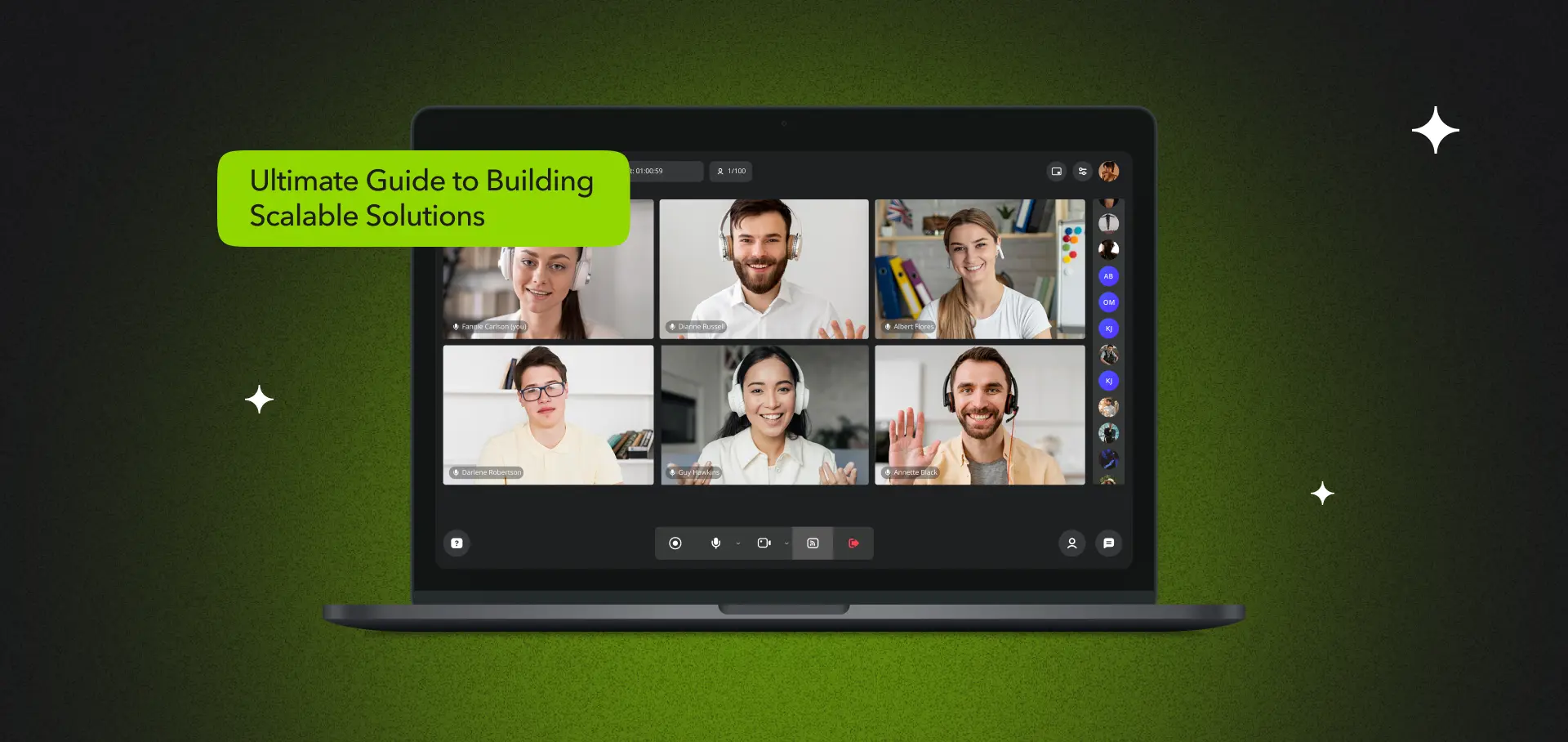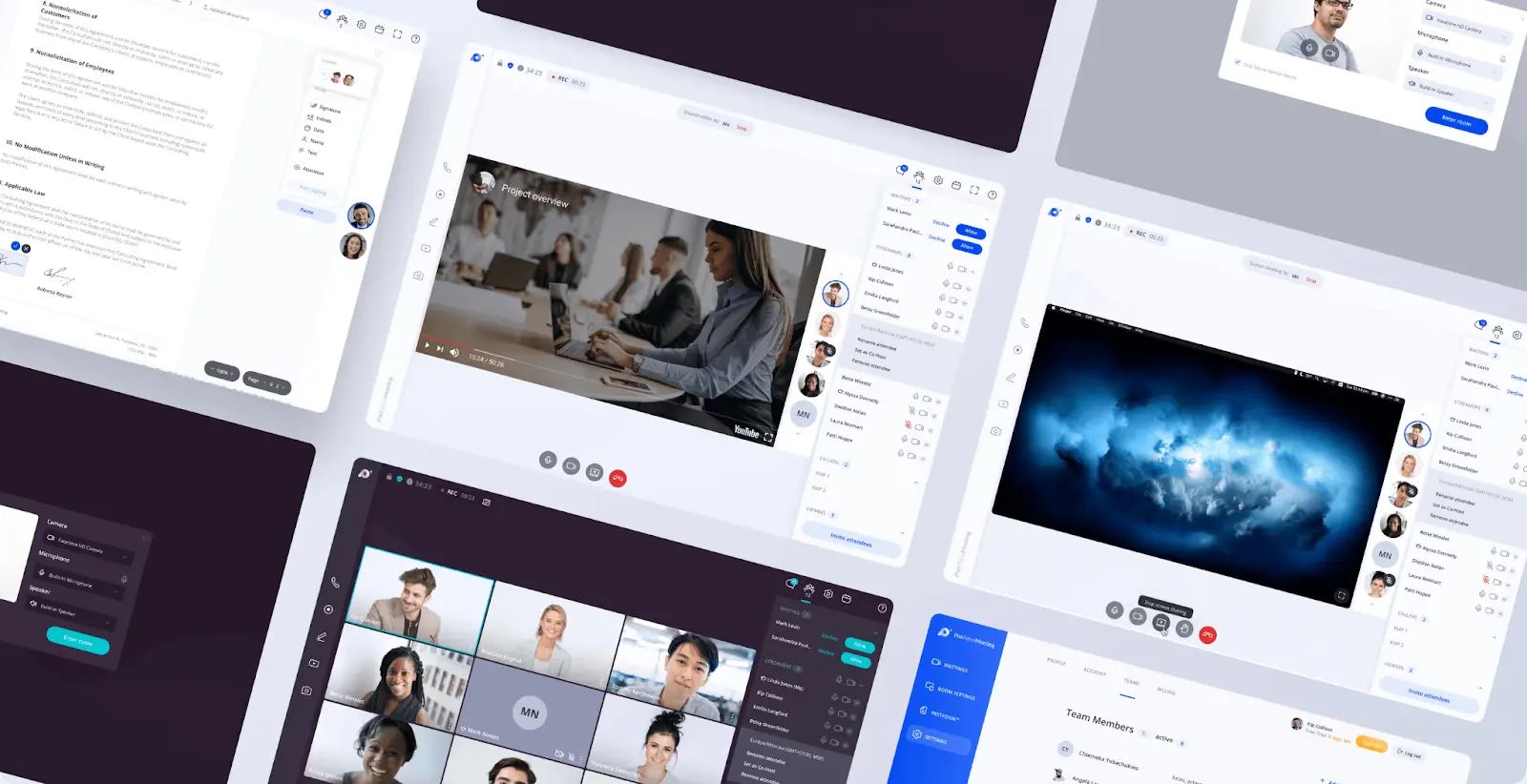
Video conferencing software has become an essential part of our daily lives, and creating one that can handle thousands of users isn't as simple as putting a camera feed online.
Modern video conferencing platforms combine several smart technologies - from WebRTC for smooth real-time chats to AI that makes your background look perfect and keeps unwanted noise away. Think of it like building a digital meeting room that needs to work perfectly for everyone who walks in. The process takes about 6 months from start to finish, starting with a basic working version in the first 2 months.
Developers focus on making sure data moves quickly between users, whether they're connecting directly to each other or through servers. They add layers of protection like end-to-end encryption to keep conversations private, just like having security guards at a physical meeting. What's really cool is how these platforms keep getting better. New features like 3D meetings and smart analytics are making online meetings feel more natural and helpful. While setting up the tech infrastructure costs quite a bit, smart planning and scalable design help make it worth the investment in the long run.
Understanding Video Conferencing Software Development

You know, the market for video conferencing software is predicted to keep growing fast until 2030.
To understand how to build these tools better, it's important to look at the main technologies and protocols that make them work.
These include things like WebRTC for real-time communication and special video coding formats like H.264.
Our Expertise in Video Conferencing Development
At Fora Soft, we bring over 19 years of specialized experience in multimedia and video streaming software development. Since 2005, we've been at the forefront of implementing cutting-edge video conferencing solutions, with a particular focus on AI integration and WebRTC technologies. Our team has successfully delivered numerous video conferencing projects across various sectors, including e-learning platforms, telemedicine systems, and enterprise communication tools.
We've earned a 100% project success rating on Upwork, demonstrating our commitment to excellence in video conferencing software development. Our expertise spans the entire development lifecycle, from initial planning and wireframing to deployment and maintenance. We've implemented advanced features like AI-powered video enhancement, real-time analytics, and secure data transmission protocols across multiple platforms, including web, mobile, and VR environments.
Market Analysis and Growth Projections Through 2030
As companies big and small turn to remote work, the video conferencing market is booming. The market's growth is driven by increased demand from various sectors, including education, healthcare, and business. Despite some market saturation, there's still ample opportunity for new entrants, especially those targeting specific customer segmentation.
The market is expected to grow at a compound annual growth rate (CAGR) of 9.9% from 2020 to 2030. This growth is attributed to the rise in remote work, distance learning, and telehealth. Moreover, technological advancements like AI and machine learning are enhancing the video conferencing experience, fuelling market growth. Understanding these trends can help software developers make informed decisions about their product's features and target audience.
Core Technologies and Protocols
Building a video conferencing software requires understanding key technologies like WebRTC. WebRTC lets users send videos and audio right from their web browsers without extra plugins.
Beyond WebRTC, developers are adding AI features to help users; for example, AI can adjust video quality or assist with automated tasks.
Furthermore, next-generation security protocols are essential. They guarantee that the data sent during video calls is encrypted and stays private. This can include modern techniques like end-to-end encryption.
WebRTC Implementation and Architecture
When developing video conferencing software, one of the most crucial technologies to understand is WebRTC (Web Real-Time Communication). It's an open-source project providing web browsers and mobile applications with real-time communications via simple APIs.
WebRTC uses peer-to-peer protocols for direct communication between users. WebRTC security is guaranteed through encryption, making it safe for data exchange. Research indicates that users' willingness to adopt secure communication tools is directly influenced by their perception of privacy risks, making WebRTC's robust security features particularly valuable (Meier et al., 2021)
The architecture includes signaling, which helps establish the connection, and media engines that handle audio and video transmission. This setup allows for low-latency, high-quality video conferencing.
Case Study: ProVideoMeeting - Elevating Business Communication

In developing ProVideoMeeting, we tackled the challenge of creating a comprehensive video conferencing solution that would stand out in a competitive market. Our approach focused on combining essential features with unique capabilities that businesses desperately needed. We integrated WebRTC and HTML5 technologies to ensure high-speed performance and automatic quality adjustment, while also implementing advanced features like legal digital signatures and flexible joining options.
AI-Driven Features and Autonomous Assistants
The integration of AI-driven features and autonomous assistants is revolutionizing video conferencing software, making it smarter and more user-friendly. These features include virtual backgrounds for privacy and chatbots for quick assistance. AI can also enhance video quality, improve noise cancellation, and provide real-time transcriptions. Below is a table highlighting some AI-driven features and their benefits.
Developers can integrate these features using AI libraries and services, making the software more appealing to end users.
Next-Generation Security Protocols
Although video conferencing software has become a fundamental part of daily life, securing these platforms has become a major concern. To combat this, developers are turning to next-generation security protocols.
Quantum encryption, for example, uses the principles of quantum mechanics to make it nearly impossible for unauthorized users to access data. Recent advancements in machine learning have significantly enhanced these quantum security systems by optimizing their performance through real-time parameter adjustments and environmental adaptation (Zhang et al., 2023).
Furthermore, biometric authentication is becoming more common. This technology uses unique physical traits, like fingerprints or facial recognition, to verify a user's identity before they can join a meeting.
Technical Implementation and Architecture
When building video conferencing software, developers choose between two main types of data transmission: P2P (peer-to-peer) and server-based solutions. P2P connects users directly but can face quality issues with many users.
While server-based solutions use a central server to manage connections, which can handle more users but requires more resources. Moreover, integrating advanced features like screen sharing or virtual backgrounds can enhance the user experience, but these features may require more complex coding and better hardware for smooth performance.
Choosing Between P2P and Server-Based Solutions
When deciding between P2P and server-based solutions for video conferencing software, developers often consider a microservices architecture to guarantee the system can handle more users without failing.
This approach distributes the workload across multiple small services, each responsible for a specific task like user management or video streaming.
Moreover, there's a growing focus on green computing, where energy-efficient infrastructure is used to minimize the environmental impact of running these services.
Microservices Architecture for Scalability
Just imagine millions of users turning to their favorite video conferencing software simultaneously to connect with friends, family, or colleagues. A microservices architecture handles this load efficiently.
It breaks the application into smaller, independent services like login, video streaming, and chat. This setup allows for better resource management through container orchestration, enabling each service to scale independently.
For instance, during peak times, more containers can be added to handle increased video streaming demands. Data sharding distributes user data across multiple servers.
This ensures smoother performance and quicker access, improving the user experience without lag.
Green Computing and Energy-Efficient Infrastructure
The quest for building efficient and environmentally sustainable video conferencing software leads developers to contemplate two primary technical implementations: Peer-to-Peer (P2P) and Server-Based solutions. P2P allows direct communication between users, reducing the need for powerful servers, and consequently promoting energy efficiency.
Server-Based solutions, on the other hand, utilize cloud sustainability to manage large scales of users but require energy efficient hardware to keep emissions low. Both approaches have trade-offs; P2P might struggle with many users, while Server-Based needs careful management to avoid high energy use.
Each offers a path to greener computing, making video conferencing more eco-friendly.
Advanced Feature Integration
Video conferencing software can offer more than just basic meetings; it can create immersive environments using AR/VR technologies to make users feel like they're in the same room.
Furthermore, integrating AI can enable real-time analytics and translation services, making meetings more insightful and accessible.
These advanced features require sturdy backend systems to process and sync data efficiently.
AR/VR Enhanced Meeting Environments
To create more immersive and interactive meeting experiences, developers are integrating Augmented Reality (AR) and Virtual Reality (VR) into video conferencing software. Features like holographic collaboration allow users to see and interact with 3D objects during meetings.
Spatial audio design ensures sound comes from the correct direction, mimicking real-life conversation. This makes virtual meetings feel more like in-person gatherings, enhancing user engagement and participation.
Developers employ AR/VR SDKs and frameworks to build these functionalities, guaranteeing compatibility with popular VR headsets and AR-enabled devices. This integration requires resilient back-end support to handle real-time data processing and synchronization across multiple users.
AI-Powered Analytics and Translation Services
Integrating AI-powered analytics and translation services can drastically enhance video conferencing software, making meetings more efficient and inclusive. These features can process vast amounts of data in real-time, providing valuable insights and services.
- Speaker Identification: AI can automatically identify who's speaking, enhancing voice modulation and enabling features like automatic transcription attribution.
- Sentiment Analysis: By analyzing voice patterns and text, AI can gauge user engagement and provide real-time feedback to ensure productive meetings.
- Language Translation: AI can break down language barriers by translating spoken words into text in the user's preferred language, promoting inclusivity.
- Meeting Summarization: AI can summarize key points, generating meeting minutes automatically and saving time for attendees.
Development Timeline and Cost Analysis
The development timeline for building scalable video conferencing software is typically broken down into several project phases and milestones. These phases include planning, design, development, testing, and deployment, each with its own set of tasks and deadlines. When designing video conferencing solutions, it's crucial to prioritize features that enhance user engagement, as synchronous video conferencing has been shown to facilitate effective two-way communication, with over 90% of students experiencing increased engagement compared to traditional formats (Camilleri & Camilleri, 2022).
Budget considerations vary greatly depending on the features required, the size of the development team, and the technology used.
Project Phases and Milestones
The development of scalable video conferencing software initiates with an MVP phase, which typically takes 8-10 weeks. This phase focuses on creating a basic but functional version of the software with core features.
Following the MVP, full feature implementation can span 16-24 weeks, where advanced capabilities and enhancements are added to improve the user experience.
MVP Development (8-10 weeks)
Developing a minimum viable product (MVP) for scalable video conferencing software typically spans 8-10 weeks. During this stage, the team works on the software's core features and user experience. They focus on making the video and audio quality great. Plus, they start thinking about branding strategies. Here's what they do:
- Basic Video/Audio Functionality: The team builds the main parts of the software that let users see and hear each other in real-time.
- User Interface Design: They create a simple, easy-to-use layout for users to navigate the software.
- Chat Feature: A basic text chat function is added so users can send messages to each other during video calls.
- Screen Sharing: The team includes a feature that lets users share their screen with others during a call.
Full Feature Implementation (16-24 weeks)
Once the MVP stage is complete, the development team moves on to the "Full Feature Implementation" phase, which generally takes 16-24 weeks. During this time, developers enhance the user experience by adding features like chat, screen sharing, and recording.
The user interface is refined for ease of use, and the software's performance is optimized for scalability. Key milestones include integrating advanced functionalities, improving security measures, and ensuring compatibility across devices.
This phase also involves rigorous testing to identify and fix bugs, ensuring a smooth user experience. The team works on making the software more intuitive, adding customization options, and improving accessibility features.
Budget Considerations
Building video conferencing software involves infrastructure and licensing costs. These costs can include servers, bandwidth, and software tools needed for development.
Optimization strategies can focus on long-term returns, like choosing scalable technologies that grow with user demand.
Infrastructure and Licensing Costs
The infrastructure and licensing costs associated with developing video conferencing software can be considerable and are influenced by several key factors such as server requirements, hosting options, and third-party service integrations.
Server costs and licensing fees are major components of the budget. Here’s a breakdown:
- Servers: You’ll need lots of servers to handle all the video and audio data.
- Hosting: This can be pricey if you’re using a cloud service.
- Software Licenses: Some tools and libraries needed might come with licensing fees.
- Third-Party Integrations: Adding features like chat or recording may require additional services.
Optimization Strategies for Long-term ROI
Before diving into infrastructure and feature requirements, let's explore how strategic planning and optimization can significantly impact the long-term return on investment (ROI) for video conferencing software. This includes understanding how user engagement and retention are affected by performance.
Factors like efficient coding practices, minimizing server load, and smart design choices influence these metrics directly. Removing unnecessary features and optimizing essential ones can keep users happy and coming back.
Continuous improvement based on user feedback also plays a big role. Regular updates ensure the software remains reliable and meets evolving user needs, enhancing overall ROI.
Video Conferencing Architecture Decision Tool
Choosing between P2P (peer-to-peer) and server-based architecture is one of the most critical decisions when building video conferencing software. This interactive tool helps you understand how different factors like user count, latency requirements, and budget constraints influence the performance and cost of each approach. Experiment with the settings to see real-time projections and make informed architectural decisions for your video conferencing project.
Frequently Asked Questions
Can I Use Open-Source Platforms for Building?
Yes, one can utilize open-source options for building projects. These platforms offer extensive customization potential, allowing developers to tailor solutions to specific needs, including the integration of AI tools.
How Do I Ensure User Privacy and Security?
To guarantee user privacy and security, implement end-to-end encryption for all communications. Enforce strong user authentication mechanisms to prevent unauthorized access. Regularly update security protocols to protect against emerging threats. Conduct routine security audits to identify and mitigate vulnerabilities.
What Are the Best Monetization Strategies for This Software?
Implementing premium features can attract paying users. Subscription models, offering tiered pricing with advanced features at higher levels, can provide a steady revenue stream. Moreover, offering custom branding for businesses or API access for developers can further monetize the software. Adopting a freemium model with basic free access and charging for premium features is also effective.
How Can I Make My Video Conferencing Software Stand Out?
To make their video conferencing software stand out, developers should focus on delivering an exceptional user experience. Incorporating competitive features such as advanced noise cancellation, high-definition video quality, and seamless integration capabilities can distinguish the software in a crowded market. Prioritizing user-friendly interfaces and resilient customer support further enhances its appeal.
What Legal Considerations Should I Be Aware Of?
When developing any software, it's essential to consider Intellectual Property protections and Regulatory Compliance. This includes understanding patent, trademark, and copyright laws to safeguard unique features and content. Moreover, adhering to data protection regulations like GDPR, CCPA, and HIPAA is indispensable to guarantee user privacy and avoid legal penalties. For video conferencing software, compliance with standards such as WebRTC for secure communication is critical. Conducting thorough research on regional laws and industry standards is necessary to navigate the complex legal landscape effectively.
To Sum Up
Building scalable video conferencing software requires a deep understanding of core technologies, such as WebRTC and SFU, and making informed decisions between P2P and server-based solutions.
The development process involves several phases, including market analysis, technical implementation, and advanced feature integration. By 2030, the market for video conferencing is expected to grow considerably, driven by remote work and education trends. Product owners should consider both the development timeline and budget to enhance their product for end users.
References
Camilleri, M., & Camilleri, A. (2022). Remote learning via video conferencing technologies: Implications for research and practice. Technology in Society, 68, Article 101881. https://doi.org/10.1016/j.techsoc.2022.101881
Meier, Y., Schäwel, J., & Krämer, N. (2021). Between protection and disclosure: Applying the privacy calculus to investigate the intended use of privacy-protecting tools and self-disclosure on different websites. Studies in Communication and Media, 10(3), 283-306. https://doi.org/10.5771/2192-4007-2021-3-283
Zhang, C., Wu, D., Cui, P.-W., et al. (2023). Research progress in quantum key distribution. Chinese Physics B, 32(12), Article 124207. https://doi.org/10.1088/1674-1056/acfd16













.avif)

Comments